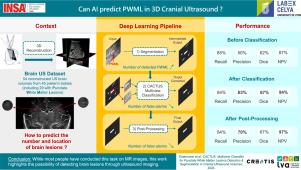CACTUS: Multiview classifier for Punctate White Matter Lesions detection & segmentation in cranial ultrasound volumes
IF 6.3
2区 医学
Q1 BIOLOGY
引用次数: 0
Abstract
Punctate white matter lesions (PWML) are the most common white matter injuries found in preterm neonates, with several studies indicating a connection between these lesions and negative long-term outcomes. Automated detection of PWML through ultrasound (US) imaging could assist doctors in diagnosis more effectively and at a lower cost than MRI. However, this task is highly challenging because of the lesions’ small size and low contrast, and the number of lesions can vary significantly between subjects. In this work, we propose a two-phase approach: (1) Segmentation using a vision transformer to increase the detection rate of lesions. (2) Multi-view classification leveraging cross-attention to reduce false positives and enhance precision. We also investigate multiple postprocessing approaches to ensure prediction quality and compare our results with what is known in MRI. Our method demonstrates improved performance in PWML detection on US images, achieving recall and precision rates of 0.84 and 0.70, respectively, representing an increase of 2% and 10% over the best published US models. Moreover, by reducing the task to a slightly simpler problem (detection of MRI-visible PWML), the model achieves 0.82 recall and 0.89 precision, which is equivalent to the latest method in MRI.

CACTUS:用于颅超声体积点状白质病变检测和分割的多视图分类器
点状白质病变(PWML)是早产儿中最常见的白质损伤,有几项研究表明这些病变与负面的长期预后之间存在联系。通过超声(US)成像自动检测PWML可以帮助医生更有效地诊断,并且比MRI成本更低。然而,由于病变体积小,对比度低,并且病变数量在受试者之间差异很大,因此这项任务极具挑战性。在这项工作中,我们提出了一种两阶段的方法:(1)使用视觉变压器进行分割,以提高病变的检出率。(2)多视角分类利用交叉关注,减少误报,提高准确率。我们还研究了多种后处理方法,以确保预测质量,并将我们的结果与MRI中已知的结果进行比较。我们的方法在美国图像的PWML检测方面表现出了改进的性能,分别实现了0.84和0.70的召回率和准确率,比已发表的最佳美国模型分别提高了2%和10%。此外,通过将任务简化为一个稍微简单的问题(检测MRI可见的PWML),该模型达到了0.82的召回率和0.89的精度,相当于MRI中最新的方法。
本文章由计算机程序翻译,如有差异,请以英文原文为准。
求助全文
约1分钟内获得全文
求助全文
来源期刊

Computers in biology and medicine
工程技术-工程:生物医学
CiteScore
11.70
自引率
10.40%
发文量
1086
审稿时长
74 days
期刊介绍:
Computers in Biology and Medicine is an international forum for sharing groundbreaking advancements in the use of computers in bioscience and medicine. This journal serves as a medium for communicating essential research, instruction, ideas, and information regarding the rapidly evolving field of computer applications in these domains. By encouraging the exchange of knowledge, we aim to facilitate progress and innovation in the utilization of computers in biology and medicine.
 求助内容:
求助内容: 应助结果提醒方式:
应助结果提醒方式:


